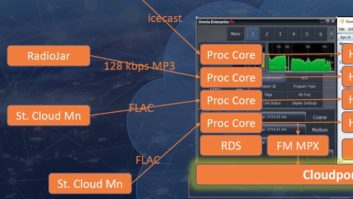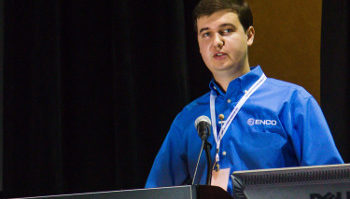GUEST COMMENTARY
By Paul Stewart
The author is broadcast automation specialist at ENCO Systems Inc.
SOUTHFIELD, Michigan — As broadcast facilities and media groups look for ways to reduce their overhead, upgrades to their existing hardware and software might not be the first idea to come to mind. However, the transition from traditional workstations to a virtual environment can help a broadcaster realize cost savings and increased reliability of their automation system throughout their facility.
WHAT’S A VIRTUAL ENVIRONMENT?

Paul Stewart is broadcast automation specialist at ENCO Systems Inc. Imagine replacing all of your production, scheduling and playout computers throughout your facility with one unit complete with individual operating systems and applications. Suddenly the large form-factor PCs and the noisy fans used to cool them disappear from the studio and are replaced with a thin client small enough to be attached to the back of a monitor mount.
Despite the workstations having been replaced with silent, passively cooled devices, the user will not notice a difference. The operating system and all applications will function as usual and it will appear to the user that the software is running on a conventional, physical computer.
Immediately, this architecture presents a few advantages over using traditional workstations in a studio. The thin clients do not require a fan to manage their internal temperature so the noise floor in the studio is reduced. Furthermore, with the mission-critical hardware out of reach of the operator, the unit is protected from accidents and can be properly maintained in a rack room down the hall. As you will see, a virtual environment presents numerous other advantages besides protecting hardware from physical wear and tear.
COST REDUCTION
One of the principle advantages of virtualization is the reduction in total cost of ownership. While the initial capital outlay may be higher than traditional automation workstations, the cost savings are realized in lower maintenance costs and lower costs of hardware upgrades.
Additionally, the cost of powering and cooling the system is drastically lower than powering and cooling the multiple computers of a traditional system, especially considering the power drawn when systems are in standby.
When contemplating the system used for a new studio build, a virtual environment may reduce deployment costs as control points are connected by simple network cabling for both AoIP and the thin clients. This simplicity is also helpful when relocating the virtual system or making additions or modifications to the virtual environment such as adding a new virtual automation workstation to a new studio.
With the virtual computing model, hardware resources are shared among the different virtual workstations. This means that when station personnel decide it is time to upgrade the hardware, the upgrades can be done quickly and with less downtime, avoiding the cost of being off the air when performing upgrades.
When all virtual workstations share a common set of hardware components, routine maintenance of the system is far less expensive than replacing or upgrading the same components on each hardware workstation. Along with being cost-effective to replace or upgrade hardware components, a virtual system also makes it easy, as there is only one centralized hardware unit on which to perform maintenance.
Many of today’s hardware units allow components and drives to be hot swapped so the virtual machines do not need to be shut down to render maintenance. This provides better uptime over traditional hardware units and allows the on-air program to continue running uninterrupted.
While a virtual environment can realize cost savings for a broadcast facility, it also provides users with numerous advantages on a day-to-day basis.
CENTRALIZED STORAGE
With a virtual system, all configuration files and assets are stored on a single hardware unit and can be accessed from any client with little effort. There are, however, inherent risks associated with centralizing data in the event of hardware failure or physical damage to the hardware unit.
To mitigate these risks, a virtual environment should be highly redundant and safeguard backup copies of assets and other mission critical files. The same principle applies to the virtual workstations. Just as some engineers insist on having a backup automation workstation or two in the event of a hardware failure, a virtual environment can include backup virtual workstations to prevent downtime. Some hardware, such as ENCO Systems’ ENCO1 units allow for a seamless recovery in the event of a hardware failure in the unit. In most cases, the operators are not aware of the failure until they receive an email notification.
Traditionally, studios have been functionally fixed; that is, an air studio was an air studio and a production studio was used for production. To create multipurpose studios was certainly possible but not always practical. Within a virtual environment, workstations are not assigned to any particular control point, thus any client can control any workstation.
With this level of versatility, and the flexibility of an AoIP routing system, any studio can be used for any purpose regardless of its original intended use. This highly redundant environment allows for easy reconfiguration, virus removal, and cloning of virtual workstations to scale upward as your facility’s needs change.
Being able to create these multipurpose studios is tremendously efficient, and allows any user to use any available studio for their needs.
Furthermore, a virtual workstation can remain powered on and playing through the playlist even if it is not assigned to a studio. The ability to run in the background can make another studio available during pre-recorded or voice-tracked shows.
A virtual automation environment has some clear benefits over the traditional workstation model and broadcasters are beginning to take advantage of the ease and versatility. It is important to assess the needs of a station and determine how a virtual environment can improve the workflow, data security, and maintenance requirements. The next time you are evaluating the automation system hardware at your facility, it may be worth your time to take a serious look at what a virtual system can do for you.
Radio World welcomes other points of view. Please send comments to [email protected].







